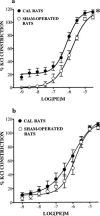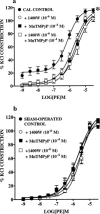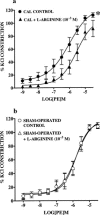Inducible nitric oxide synthase-derived superoxide contributes to hypereactivity in small mesenteric arteries from a rat model of chronic heart failure
- PMID: 10960065
- PMCID: PMC1572288
- DOI: 10.1038/sj.bjp.0703528
Inducible nitric oxide synthase-derived superoxide contributes to hypereactivity in small mesenteric arteries from a rat model of chronic heart failure
Abstract
The aims of this study were to (a) determine whether inducible nitric oxide synthase (iNOS) is expressed in small mesenteric arteries from rats with chronic heart failure (CHF), (b) investigate the functional significance of this potential source of nitric oxide (NO) on vascular responsiveness and (c) investigate the role that superoxide plays in modulating vascular function in these arteries. CHF was induced in male Wistar rats by coronary artery ligation (CAL). In sham-operated rats the ligature was not tied but pulled under the artery. Six weeks after surgery CAL rats had left ventricular (LV) infarctions and elevated LV end-diastolic pressures. Immunoreactive iNOS was found in endothelial cells, vascular smooth muscle cells and in the adventitia of small mesenteric arteries from CAL rats but not those from sham-operated rats. Third order mesenteric arteries (300-350 microm) were mounted in a small vessel pressure myograph. Endothelium-intact arteries from CAL rats were more responsive to phenylephrine (PE) than arteries from sham-operated rats (pD(2) value, CAL, 6.2+/-0.1; sham-operated, 5.9+/-0.1, P<0.05). Both the selective iNOS inhibitor, N-(3-(Aminomethyl) benzyl) acetamidine dihydrochloride (1400W; 10(-6) M) and the superoxide dismutase mimetic, Mn [III] tetrakis [1-methyl-4-pyridyl] porphyrin, (MnTMPyP; 10(-4) M) reversed the hyperesponsiveness (pD(2) values, 1400W, 5.9+/-0.1; MnTMPyP, 5.81+/-0.1, P<0.05). The NOS substrate, L-arginine (10(-3) M), reduced responsiveness of endothelium-denuded small mesenteric arteries from CAL rats (P<0.01). None of these drugs altered responses to PE in arteries from sham-operated rats. In summary, this study demonstrates that iNOS is expressed in mesenteric arteries from rats with CHF. However, instead of generating large quantities of NO, iNOS appears to be generating superoxide, perhaps because of a deficiency in its substrate, L-arginine. Increased superoxide generation from iNOS contributes to the hyperesponsive nature of endothelium-intact small mesenteric arteries from rats with CHF.
Figures




Similar articles
-
[Alterations in aortic vasomotor function in rats with chronic heart failure and its mechanism].Sheng Li Xue Bao. 2010 Aug 25;62(4):317-24. Sheng Li Xue Bao. 2010. PMID: 20717632 Chinese.
-
alpha2-Adrenoceptor subsensitivity in mesenteric vascular bed of cholestatic rats: the role of nitric oxide and endogenous opioids.Eur J Pharmacol. 2005 May 9;514(2-3):183-9. doi: 10.1016/j.ejphar.2005.03.015. Eur J Pharmacol. 2005. PMID: 15910805
-
Lipopolysaccharide-induced impairment of nitric oxide-mediated vasorelaxation and protective effects of nitric oxide synthesis inhibitors in isolated rat mesenteric arteries.Arzneimittelforschung. 2010;60(6):315-9. doi: 10.1055/s-0031-1296293. Arzneimittelforschung. 2010. PMID: 20648920
-
Nitric oxide in coronary artery disease: roles in atherosclerosis, myocardial reperfusion and heart failure.EXS. 1996;76:33-55. doi: 10.1007/978-3-0348-8988-9_3. EXS. 1996. PMID: 8805787 Review.
-
Vascular dysfunction and heart failure: epiphenomenon or etiologic agent?Am Heart J. 2002 Mar;143(3):383-90. doi: 10.1067/mhj.2002.120780. Am Heart J. 2002. PMID: 11868041 Review.
Cited by
-
Nitrosative stress and pharmacological modulation of heart failure.Trends Pharmacol Sci. 2005 Jun;26(6):302-10. doi: 10.1016/j.tips.2005.04.003. Trends Pharmacol Sci. 2005. PMID: 15925705 Free PMC article. Review.
-
Role of calcium channels responsible for phenylephrine-induced contraction in rat aorta 3 days after acute myocardial infarction.Korean J Anesthesiol. 2014 Feb;66(2):143-52. doi: 10.4097/kjae.2014.66.2.143. Epub 2014 Feb 28. Korean J Anesthesiol. 2014. PMID: 24624273 Free PMC article.
-
Role of increased guanosine triphosphate cyclohydrolase-1 expression and tetrahydrobiopterin levels upon T cell activation.J Biol Chem. 2011 Apr 22;286(16):13846-51. doi: 10.1074/jbc.M110.191023. Epub 2011 Feb 22. J Biol Chem. 2011. PMID: 21343293 Free PMC article.
-
Role of reactive oxygen species and gp91phox in endothelial dysfunction of pulmonary arteries induced by chronic hypoxia.Br J Pharmacol. 2006 Jul;148(5):714-23. doi: 10.1038/sj.bjp.0706779. Epub 2006 May 22. Br J Pharmacol. 2006. PMID: 16715116 Free PMC article.
-
Myogenic constriction is increased in mesenteric resistance arteries from rats with chronic heart failure: instantaneous counteraction by acute AT1 receptor blockade.Br J Pharmacol. 2003 Aug;139(7):1317-25. doi: 10.1038/sj.bjp.0705367. Br J Pharmacol. 2003. PMID: 12890711 Free PMC article.
References
-
- ADAMS V., YU J., MOBIUS-WINKLER S., LINKE A., WEIGL C., HILBRICH L., SCHULER G., HAMBRECHT R. Increased inducible nitric oxide synthase in skeletal muscle biopsies from patients with chronic heart failure. Biochem. Mol. Med. 1997;61:152–160. - PubMed
-
- BAUERSACHS J., BOULOUMIÉ A., FRACCAROLLO D., HU K., BUSSE R., ERTL G. Endothelial dysfunction in chronic myocardial infarction despite increased vascular endothelial nitric oxide synthase and soluble guanylate cyclase expression. Role of enhanced vascular superoxide production. Circulation. 1999;100:292–298. - PubMed
-
- CARVILLE C., ADNOT S., SEDIAME S., BENACERRAF S., CASTAIGNE A., CALVO F., DE CREMOU P., DUBOIS-RANDÉ J.-L. Relation between impairment of nitric oxide pathway and clinical status in patients with congestive heart failure. J. Cardiovasc. Pharmacol. 1998;32:562–570. - PubMed
-
- DREXLER H., HAYOZ D., MUNZEL T., HORNIG B., JUST H., BRUNNER H.R., ZELIS R. Endothelial function in chronic congestive heart failure. Am. J. Cardiol. 1992;69:1596–1601. - PubMed
Publication types
MeSH terms
Substances
LinkOut - more resources
Full Text Sources
Medical

